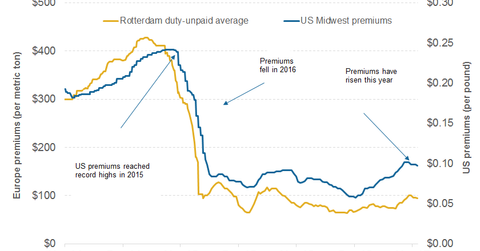What Should Alcoa Investors Make of Aluminum Premiums?
Aluminum premiums are key indicators that investors in primary producers such as Century Aluminum (CENX), Norsk Hydro (NHYDY), and Rio Tinto (RIO) should track.
April 4 2017, Updated 2:35 p.m. ET

Aluminum premiums
For aluminum producers, the all-in aluminum price consists of aluminum’s price plus regional aluminum premiums. These premiums are surcharges that consumers must pay on top of prevailing prices in order to take immediate delivery of the metal from warehouses.
Aluminum premiums are key indicators that investors in primary producers such as Century Aluminum (CENX), Norsk Hydro (NHYDY), and Rio Tinto (RIO) should track.
Reflective of physical markets
Unlike aluminum prices, which are decided through electronic trading, premiums are regional in nature and are settled between actual buyers and sellers.
Some producers such as Alcoa (AA) see physical premiums as better reflections of the aluminum market than LME (London Metal Exchange) aluminum prices (DBB).
US versus European premiums
The above graph shows the movement in spot US Midwest aluminum premiums (MDY) (MID-INDEX) as reported by Metal Bulletin. Delivery premiums have shown some strength in 2017. We’ve seen some upward traction in European delivery premiums as well, as the graph above shows.
However, while aluminum prices have seen significant upward movement, there hasn’t been an equal rise in physical premiums as expected. This divergence could reflect the disconnect between the physical and financial markets.
While trading activity and market sentiments can influence aluminum prices, premiums offer insights into physical markets. The divergence between delivery premiums and aluminum prices shows that physical market participants don’t necessarily share the same optimism as financial market participants.
There’s a significant divergence in the aluminum market’s 2017 outlook. We’ll discuss this divergence in detail in the next article.
